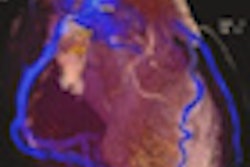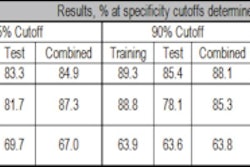New guidelines published last week on the appropriate use of coronary CT angiography generally recommend broader use in low- and intermediate-risk patients, while discouraging use in high-risk patients or for multiple coronary calcium exams.
The guidelines were published by the American College of Cardiology Foundation (ACCF), along with several other imaging societies. The document, released concurrently in multiple journals, replaces the 2006 guidelines on the topic and reflect "changes in test utilization in the context of rapidly developing technical and clinical applications and within the conceptual framework of dynamic appropriate use criteria development," wrote authors Allen Taylor, MD; Manuel Cerqueira, MD; and colleagues (Journal of the American College of Cardiology, October 26, 2010).
The report describes clinical scenarios reflecting the most common and important indications currently in use for cardiac CT (CCT). Of note, the new guidelines highlight CT's alignment with and decision-support tools corresponding to the 2009 appropriate use criteria for radionuclide imaging.
The guidelines also aim to clarify the appropriateness of cardiac CT in various clinical scenarios. "In general, use of CCT angiography for diagnosis and risk assessment in patients with low or intermediate risk or pretest probability for coronary artery disease (CAD) was viewed favorably, whereas testing in high-risk patients, routine repeat testing, and general screening in certain clinical scenarios were viewed less favorably," the authors wrote. "Use of noncontrast CT for calcium scoring was rated as appropriate within intermediate- and selected low-risk patients."
The guidelines -- written by the ACCF in cooperation with the Society for Cardiovascular Magnetic Resonance, the American Society of Nuclear Cardiology, the Society for Cardiovascular Angiography and Interventions, the American Heart Association, the American Society of Echocardiography, the Society of Cardiovascular Computed Tomography, and the American College of Radiology -- consider CT appropriate for evaluating both cardiac structure and function.
"It is anticipated that these results will have an impact on physician decision-making, performance, and reimbursement policy, and that they will help guide future research," the authors wrote.
Patients with regular heart rates and rhythm appropriate to the scanner capabilities were still those best suited to cardiac CT evaluation, they wrote, and, in general, the best patients have a body mass index of 40 or lower, when the use of iodinated contrast is considered.
While 31 indications were carried over from the 2006 recommendations, the new guidelines contain a significant expansion of criteria for symptomatic patients without known coronary artery disease, Taylor and colleagues noted.
"CCT was felt to be appropriate primarily for situations involving a low or intermediate pretest probability of obstructive CAD," they wrote. "Scenarios involving high-probability CAD patients were rated as uncertain with the exceptions of a patient with an interpretable electrocardiogram who was able to exercise, and for definite myocardial infarction."
Noncontrast CT calcium scoring was considered appropriate for patients at intermediate risk of coronary heart disease, and for low-risk patients with a family history of disease.
"Screening asymptomatic patients using coronary CT angiography was considered inappropriate, as was repeat coronary calcium testing," Taylor and colleagues wrote. "Repeat CT angiography in asymptomatic patients or patients with stable symptoms with prior test results was broadly considered inappropriate."
Coronary CT angiography was considered appropriate or uncertain for patients with both normal and abnormal left ventricular ejection fractions, but the only appropriate scenarios were patients with reduced ejection fraction at low or intermediate pretest probability of disease.
Preoperative CT angiography was deemed appropriate for both heart surgery and noncoronary indications in the setting of either intermediate (appropriate) or low (uncertain) risk of coronary artery disease.
Stent evaluation with CT was generally felt to be appropriate in the context of patient symptoms and status. "Only with larger stents (≥ 3 mm in diameter) after long time periods (≥ 2 years) was stent imaging considered uncertain, and only with left main stents was imaging of stents considered appropriate," Taylor and his team wrote.
The authors considered evaluation of cardiac structure and function as strengths of coronary CT, including the evaluation of coronary anomalies, right and left ventricular function, prosthetic heart valves, and left ventricular ejection fraction when the results of other modalities are inadequate. Myocardial viability assessment with CT was also added to the new guidelines for use "when other modalities are inadequate or contraindicated," they wrote.
"As with other appropriate use criteria, some of these ratings will require research and further evaluation to provide the greatest information and benefit to clinical decision-making," the group concluded.
By Eric Barnes
AuntMinnie.com staff writer
November 1, 2010
Related Reading
CT calcium scoring alters cardiac risk estimates, October 14, 2010
Heart groups update cardiac radionuclide guidelines, June 11, 2009
SCCT publishes cardiac CTA guidelines, May 7, 2009
Framingham risk doesn't predict plaque burden, January 5, 2009
AHA urges cautious use of coronary CTA and MRA, July 9, 2008
Copyright © 2010 AuntMinnie.com




















